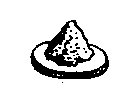Moxibustion with Moxa Cone
Moxibustion with moxa cones may be direct or indirect. Direct moxibustion is to place a moxa cone directly on the skin and ignite it, while indirect moxibustion is to place a moxa cone indirectly on the skin but insulated with some different medical substances. The names are nomenclatured according to the names of the different medical substances, for example, ginger used as the insulator is called moxibustion with ginger ; salt used for insulation is called moxibustion with salt. One moxa cone used at one point is called one unit.
 Direct moxibustion. A moxa cone place directly on the point and ignited is called direct moxibustion, and is also known as " open moxibustion, " which was widely used in the ancient times with better results. This type of moxibustion is subdivided into scarring moxibustion and nonscarring moxibustion according to whether the local scar is formed or not after moxibustion.
Direct moxibustion. A moxa cone place directly on the point and ignited is called direct moxibustion, and is also known as " open moxibustion, " which was widely used in the ancient times with better results. This type of moxibustion is subdivided into scarring moxibustion and nonscarring moxibustion according to whether the local scar is formed or not after moxibustion.
-
Scarring moxibustion ( also known as " festering moxibustion " ) :
Prior to moxibustion, apply some onion or garlic juice to the site in order to increase the adhesion of the moxa cone to the skin, then put the moxa cone on the point and ignite it until it completely burns out. Repeat this procedure for five to ten units. This method may lead to a local bum, blister,
festering and scar after healing. Indications are certain chronic diseases such as asthma.
-
Nonscarring moxibustion : A moxa cone is placed on a point and ignited. When half or two thirds of it is burnt or the patient feels a burning discomfort, remove the cone and place another one. No blister should be formed and there should be no festering and scar formation. Indications are diseases of chronic, deficient and cold nature such as asthma, chronic diarrhoea, indigestion, etc.
Indirect moxibustion : The ignited moxa cone does not rest on the skin directly but is insulated from the skin by one of four types of materials.
-
Moxibustion with ginger : Cut a slice of ginger about 0.5 cm thick, punch numerous holes on it and place it on the point selected. On top of this piece of ginger, a large moxa cone is. placed and ignited. When the patient feels it scorching, remove it and light another. This method is indicated in symptoms caused by weakness of the stomach and spleen such as diarrhoea, abdominal pain, painful joints and symptoms due to yang deficiency.
-
Moxibustion with garlic : Cut a slice of garlic about 0.5 cm thick ( a large single clove of garlic is
desirable ) , punch holes in it, put it on the point with theignited moxa cone above. Renew the cone when the patient feels it scorching. This method is indicated in scrofula, tuberculosis, the early stage of skin ulcer with boils, poisonous insect bite, etc.
-
Moxibustion with salt : This is usually applied at the umbilicus, so it is also called " moxibustion at Shenque point. " Fill the umbilicus with salt to the level of the skin, place a large moxa cone on the top of salt and then ignite it. ( If the patient ' s umbilicus is not concave in shape, a piece of wet noodle can be put around the umbilicus then fill salt in it. The moxa cone can be placed and ignited on the top of it. ) This method is effective in cases of abdominal pain, vomiting and diarrhea, pain around the umbilicus, pain caused by hernia, prolonged dysentery, etc. In addition, moxibustion with salt has the function to restore yang from collapse, e.g. symptoms of excessive sweating, cold limbs and undetectable pulse. Large moxa cones may be used successively until sweating stops, pulse restores and the four extremities get warm.
-
Moxibustion with monkshood cake : A coin - sized cake made of monkshood powder mixed with alcohol, is punched with numerous holes in it, and placed on the site for moxibustion with the moxa cone ignited and burnt on the top of it. Since it is of heat nature, the monkshood may warm yang and expel cold. This method is only suitable to treat deficient, and persistent yin - cold syndromes, such as impotence and ejaculatio precox caused by declination of the Mingmen fire.
|
